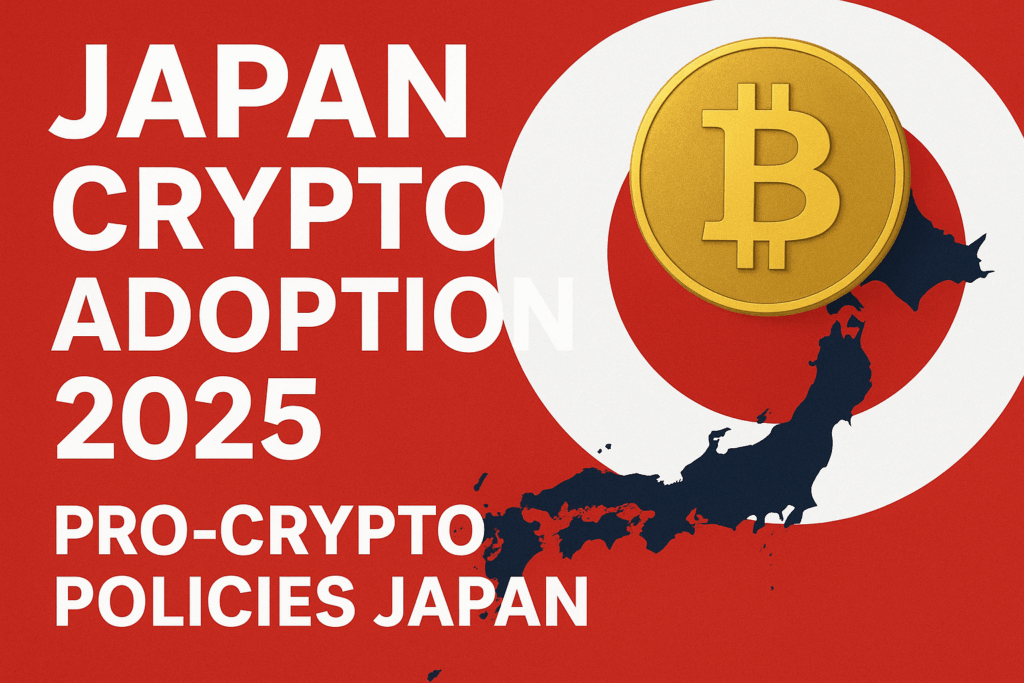Japan stands at a turning point in the digital-asset arena. In 2025, the country isn’t just observing crypto evolution — it’s actively reshaping policies and infrastructure to boost adoption. This article explores key drivers, recent policy shifts, market impact, and what it all means moving forward.
What’s happening in Japan’s crypto market?
According to Chainalysis, Japan’s on-chain value received grew by 120% year-on-year through June 2025 — the strongest among major Asia-Pacific markets.
The estimated crypto adoption rate in Japan in 2025 is ~ 14.70% of the population, projected to rise to ~15.26% by 2026.
Institutional players and stablecoin issuance are gaining traction. Japan is no longer purely speculative for retail—it’s moving toward integrated digital-asset infrastructure.
Key policy & regulatory changes driving adoption
The Financial Services Agency (FSA) is proposing to reclassify crypto assets as financial products (under the Financial Instruments & Exchange Act) — making them more formally aligned with securities/traditional finance. Implementation target ~2026.
Tax reform is on the radar: proposals include moving from progressive tax rates (which can go up to ~ 55%) toward a flat ~20% tax on crypto gains, and permitting loss carryforwards.
Stablecoin regulation & licensing: Japan has green-lit its first yen-pegged stablecoin (or is in the advanced steps). Ease of stablecoin issuance helps payment / settlement use-cases, not just trading.
Payment/finance integration: Example — partnership between Binance Japan and the payments platform PayPay Corp., enabling crypto + QR/cashless payments across a large user base.
Why these changes matter — adoption & ecosystem impact
With regulatory clarity (classification, taxation, custody) comes reduced risk for both investors and firms — this tends to spur institutional participation, higher liquidity, more service offerings.
Stablecoins + easier on/off-ramps = crypto becomes more usable (payments, transfers, fintech) rather than purely speculative. Japan is leaning into that.
Market perception: a pro-crypto or crypto-friendly environment helps attract startups, blockchain/fintech innovation, and possibly foreign capital. Japan’s push may make Tokyo / Japan a stronger Web3 / blockchain hub in Asia.
Challenges & things to watch
Even with positive policy signals, full reforms (e.g., legal reclassification, tax changes) may take time (2026+). Adoption won’t instantly scale unless supporting infrastructure, user-education, and trust are in place.
Taxation & compliance still remain tough for many individual investors in Japan; previous high rates plus complex rules have been barriers.
Global/regional competition: other Asia-Pacific markets (like South Korea, Singapore, India) also are active in crypto/Web3 — Japan needs to maintain momentum to lead.
Macro environment: Digital-asset adoption is influenced by macro finance trends (interest rates, currency stability, regulatory shifts abroad). Japan’s weaker yen, domestic investment climate, etc. all matter.
What this means for investors / adopters
For retail investors: clearer regulation + lower tax burden (if reforms pass) = easier entry and possibly lower friction in using crypto. But still — due diligence, wallet custody, exchange security remain critical.
For fintech / startup builders: Japan looks increasingly favorable for launching crypto-services, stablecoin solutions, DeFi / Web3 integrations, especially if you align with regulatory/AML/consumer-protection frameworks.
For travel / payments industry: As your site (BarqAndAzTravel) operates in travel, you might consider how crypto or blockchain payments could integrate into travel packages, cross-border payments, loyalty programmes, or digital payment solutions for international travellers into/out of Japan. The pro-crypto trend may open more payment options.
Long term: The interplay of crypto + digital fiat (e.g., digital yen / CBDC) + blockchain-enabled cross-border settlement could reshape parts of Japan’s travel / remittance / payments ecosystem. Monitoring policy + adoption is wise.
Outlook for Japan Crypto in 2025–2026
We expect modest but meaningful growth in crypto adoption in Japan through end of 2025, with acceleration in 2026 once major policy reforms take effect (legal classification, taxation, stablecoin issuance).
Japan is well-positioned to become one of Asia’s crypto-friendly hubs, but success hinges on execution: that means effective regulation + enforcement + supporting fintech/startups + user trust.
Travel/payment industries, cross-border services, and international travellers will increasingly encounter more crypto-friendly infrastructure in Japan — which may create niche opportunities (e.g., crypto-based travel payments, blockchain loyalty for travellers, etc).
Conclusion:
Japan’s pro-crypto policies in 2025 are more than just symbolic — they’re enabling infrastructure, legal clarity, and payment innovation that can drive real adoption. For sectors like travel, fintech, payments (including your domain), the ripple effects are worth paying attention to. As reforms progress into 2026, the shift from “crypto curiosity” to “crypto usability” in Japan looks increasingly plausible.





